|
|
Melton

|
|
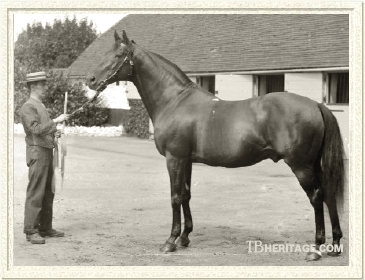 |
|
|
For some, everything just seems to fall into place the right way. Such was the case with George Manners Astley, the 20th Baron Hastings. Born in 1857, he inherited his title upon the death of his unmarried elder brother Bernard in 1875. The young baron was no relation to Henry Weysford Charles Plantagenet Rawford-Hastings, the 4th Marquess of Hastings, who squandered his inheritance through reckless gambling and turf misadventures and died a broken man at the age of 26 in 1868.
Fond of several sports, including cricket, yachting, and hunting, young Baron Hastings entered the sport of racing Thoroughbreds at the age of 21. He did not go in without help, and chose Captain James Machell, one of the shrewdest judges of a good horse, as his mentor. Two early acquisitions for young Baron Hastings were the colt Master Kildare and the filly Violet Melrose. Put together, in 1882 they produced Baron Hastings's only classic winner, and that was Melton. A small bay colt, Melton definitely was not the most handsome specimen of the thoroughbred. But he had an extraordinary range of ability. He was a top flight two-year-old, a multiple classic winner at three, and at four, won at both sprinting and classic distances. His progeny seemed to have the same range of ability as their sire, for he got precocious juveniles and top performers at the classic distances. One of his sons, American-raced SYSONBY, was a brilliant two-year-old and dominant as a three-year-old at distances of a mile to a mile-and-five-eighths. The only blemish on Melton's siring record was his failure to sire an English classic winner. However, he was a formidable sire of broodmares, as three of his daughters produced five English classic winners between them.
Melton's sire, Master Kildare was the first good horse campaigned by Lord Hastings. Foaled in 1875, Master Kildare was sired by Lord Ronald, a beautifully bred son of Stockwell and the Newminster mare Edith. Lord Ronald was a winner of the Salisbury Cup, but accomplished little else. His owner, Henry Somerset, the 8th Duke of Beaufort, sent the colt to Epsom to be schooled for jumping, something the horse was reluctant to perform. Sent to Tattersalls to be sold, he was purchased by Edward Chapman Clayton for 140 guineas. For his new owner, Lord Ronald, with patience, became a fine hunter. He was sold after two years for 400 guineas and sent to Ireland to sire hunters. His best runner aside from Master Kildare was The Cob, also owned and bred by the Duke of Beaufort, who was a winner of several races, including the Salisbury Cup and Great Metropolitan Handicap.
Dam of Master Kildare was the Irish-bred mare Silk, owned by Plunkett Kenny. She had accomplished nothing on the turf, but she possessed an interesting pedigree. Her sire, Irish-bred Plum Pudding, was a full brother to English Oaks winner Mincepie.
Master Kildare, a handsome chestnut, was unbeaten as a juvenile in Ireland. He became the property of Lord Lonsdale, for whom he finished third to the filly Jannette in the St. Leger. Captain James Machell took a strong liking to Master Kildare, and purchased him with the intention of re-selling him at a profit. In 1879, he urged young Lord Hastings to buy him. In England, Master Kildare had been trained by Matt Dawson, and Lord Hastings kept Master Kildare in Dawson's care. For his enthusiastic young owner, Master Kildare won the Alexandra Plate at four and the City and Suburban Handicap at Epsom at five. Dawson held a high opinion of Master Kildare, and prevailed upon Lord Hastings to keep him as a stallion. He was sent to stand at the Burghley Paddocks, Stamford, at a fee of twenty guineas. Unfortunately, other breeders did not share Dawson's high regard for Master Kildare, and there were only three reported foals from his first crop and all were bred by Lord Hastings. Master Kildare enjoyed a long stud career in which he proved a useful sire, though Melton was his only English classic winner. His winners included the speedy Pearl Diver (1882), later sold to South Africa, where he was leading sire in five successive years; Monti, foaled in 1899 and winner of Poland's classic Nagroda St. Leger in 1902; and Wilful (1895), winner in Hungary of the Magyar Kanca dij.
Melton's dam, Violet Melrose (1875), won six races, including the Earl of Chester's Welter Plate. Her sire was Ascot Gold Cup winner Scottish Chief, whose own sire, Lord of the Isles, by Touchstone, had won the Two Thousand Guineas and placed third in the Derby. Scottish Chief was a useful stallion, having sired a number of good juveniles, including King of the Forest (1868), who took Doncaster's Champagne Stakes; Pursebearer (1879), winner of the Gimcrack Stakes; Dunmore (1879), winner of Epsom's Woodcote Stakes; Childeric (1875), who took Newmarket's Chesterfield Stakes, and Strathfleet (1875), winner of Newmarket's July Stakes. His best was the exceptional filly Marie Stuart, winner of the Oaks, St. Leger, Coronation Stakes, and Yorkshire Oaks in 1873, but he also got Maid of Perth (1869), winner of the Yorkshire Oaks and the Nassau Stakes, and some good stayers, including King of the Forest. A Scottish Chief son, Taurus (1879), went to Austria-Hungary, where he won the Oesterreichisches Derby, the Austria Trial Stakes, and the Deutsches Derby.
Violet Melrose hailed from the family of Beeswing, her third dam, the Touchstone mare Honeysuckle, was a full sister to St. Leger winner Newminster and Two Thousand Guineas winner Nunnykirk. A full sister to Violet Melrose, Miss Middlewick, owned by the 6th Duke of Portland, would become the dam of the Duke's 1893 Oaks winner Mrs. Butterwick.
Melton on the Turf
Melton was trained by Matthew Dawson at Newmarket, and though a small colt, it was soon recognized from his training that he possessed high quality. He made his racecourse debut as a two-year-old in the New Stakes at Ascot. He won over the filly Match Girl. The third-place finisher, Langwell, would go on to capture the Champagne Stakes later in the season. Melton lost his next race, the July Stakes at Newmarket, but was hardly shamed in the process. He lost by a scant head to the more experienced Luminary, winner previously of the Biennial Stakes at Ascot and the Hurstbourne Stakes.
Under 129 pounds for his next start, the Middle Park Plate, Melton redeemed himself with a half-length victory over Xaintrailles, a highly-regarded French colt, with Royal Hampton and Paradox dead-heating for third place. The last start of the season for Melton was the Criterion Stakes at Newmarket, which he won by a length and a half from Golden Ray, winner of the Rous Memorial Stakes at Goodwood.
Melton made his first start as a three-year-old in the Payne Stakes at Newmarket, thereby missing the Two Thousand Guineas, which was won easily by Paradox. Melton took the Payne with minimal effort, and then prepared to face-off with Paradox and eleven others in the Derby on June 3, 1885. Despite not having started in the Two Thousand Guineas, Melton went off as the favorite in the Epsom classic, and the race turned out to be a struggle between Melton and Paradox.
His primary rival, Paradox, was an extraordinary colt in his own right. The son of Sterling had been purchased for £700 from his breeders, the Graham brothers, by trainer John Porter, who went into partnership on the colt with a close friend, Captain Bowler. The two men then turned a quick profit by selling the colt for £6000 before he raced to the 1st Duke of Westminster. His first race for the Duke was in the Middle Park Plate, won by Melton. The Duke promptly repented of his purchase, and sold Paradox to American Broderick Cloete, for whom Paradox won the Dewhurst Plate in his first start for his new owner. Paradox was regularly partnered by Fred Archer, and it was Archer who piloted the idiosyncratic colt to victory in the Two Thousand Guineas at Newmarket.
For the Derby, Matt Dawson had first call for Archer's services, and so Archer rode Melton, while Paradox was partnered by Frank Webb. Archer knew of Paradox's habit of easing himself up once he reached the front, and used that knowledge to his advantage in the ride he gave Melton. In a display of cold calculation under extreme pressure, Archer allowed Paradox and Webb to seize the lead close to the finish and then drove Melton for all he was worth to cross the line the victor by a mere head.
Less then a week later, Archer, re-united with Paradox, used the same nail-biting tactics to capture the Grand Prix de Paris at Longchamp. Paradox proved an unlucky loser of the Derby, for after the Grand Prix, he went on to capture the Sussex Stakes at Goodwood and the Champion Stakes at Newmarket to put the seal on a brilliant three-year-old campaign.
Melton, on the other hand, was shelved for the remainder of the summer, and was not seen again until he went postward for the St. Leger at Doncaster in September. The rest must have done him a world of good, as he won the final classic by six lengths, and then added the Great Foal Stakes at Newmarket for good measure to close out his season.
Matt Dawson chose a tough spot for Melton to return to competition as a four-year-old. In the Hardwicke Stakes at Royal Ascot, Melton could get no closer than two lengths to the Duke of Westminster's brilliant three-year-old Ormonde, the unbeaten winner so far that season of the Two thousand Guineas and the Derby.
Melton was kept out of Ormonde's way, and enjoyed a walk-over for the Newcastle Gold Cup, and then demonstrated his ability sprinting with a three length victory in the July Stakes. A comfortable three-length victory in the one mile Leicestershire Cup followed. Melton could not handle 146 pounds in the Stewards' Cup at Goodwood, finishing unplaced to Crafton, carrying 111 pounds. Two days later, in Goodwood's Chesterfield Cup, Melton was again asked to carry 146 pounds, and ran unplaced to Saraband. Melton was unplaced twice more that season, in the October Handicap at Newmarket, under 135 pounds and the Cambridgeshire Stakes under 133 pounds. In the Jockey Club Cup at Newmarket, Melton was beaten by eight lengths by five-year-old St. Gatien, the dead-heat winner with Harvester of the Derby two years previously.
The last race of Melton's career came in the Liverpool Autumn Cup. Under 129 pounds, he won by two lengths while conceding no less than seventeen pounds to the other seventeen runners.
Melton in the Stud
A winner of eleven races in eighteen starts, Melton was retired to stud to stand at Newmarket's Falmouth House Paddocks for a fee of 50 guineas. After one season he was moved to the Hampton Court stud. After three seasons in England, he was sold to the Italian government for £10,000 and sent to stand stud near Pisa, commencing with the 1890 season. By 1897, he was back in England, this time at Mr. J. Musker's Westerham Hill Stud, near Kent.
Melton did not set the English breeding world on its head in his first few seasons at stud. Some good individuals to come from these early crops were AVINGTON, BULLINGDON and BEST MAN. BULLINGDON was a winner of the Produce Stakes and Prince of Wales's Stakes at Goodwood and the Midsummer Plate at Newmarket. He was second in the Coventry Stakes as a two-year-old to Ladas, second to Isinglass in the Princess of Wales's Stakes at three, with Ladas third. He was also fourth to Ladas in the Derby.
|
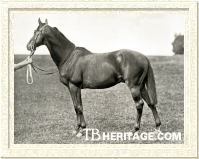
Avington, an early winner in England
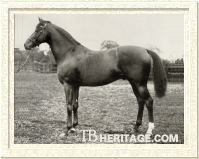
Best Man's exploits brought Melton back to England
| |
AVINGTON, out of The Speaker mare Annette, was a winner of the Duke of York Stakes and the Jubilee Stakes. He was bred and raced by the 1st Duke of Westminster, and was out of the Duke's Two Thousand Guineas and Derby winner Shotover. AVINGTON, who never won a race over eight furlongs, later got winners of thirty-three races (excluding juveniles), half of which won between eight and eleven furlongs, the rest stayers. His best was the colt Achilles, winner at two of the 1905 Champagne Stakes, as well as second to Pretty Polly in the Coronation Cup and third to Bachelor's Button and Pretty Polly in the Ascot Gold Cup the next season. Like many Melton sons, his offspring were frequently sold to the foreign market, and he had winners in Belgium, Germany, India, Russia, and South Africa.
BEST MAN (1890, from Wedlock, by Wenlock), was the best of Melton's racehorses in the early years, but by the time he reached his peak, at age four, Melton was in Italy. He was the Melton son to continue the sire line. BEST MAN'S son, Signorino, was also sent to Italy, where he was highly successful; among his progeny was Michelangelo, a winner of four classic races in Italy for Federico Tesio of Razza del Soldo. Michelangelo got Navarro (1931), one of the best horses ever to run in Italy (for the Tesio-Incisa partnership) and later a leading sire in that country. Navarro was, to all intents and purposes, the last of the sire line, but he was also a successful broodmare sire, and his daughters' descendants represent him in pedigrees today. |
BEST MAN won four of his nine starts as a juvenile, the best of which was Newmarket's Cheveley Stakes. At age three, 1893, he won four of nine starts, including Newmarket's Hastings Plate and Great Eastern Railway Handicap, and the 8 furlong Derby Cup at Derby. He only got better at age four, winning eight of his nine races, and dead-heating in the ninth, the Queens Prize at Kempton Park. His best wins were Newmarket's 6 furlong July Cup, Ascot's Trial Stakes (7 furlongs) and Queen's Stand Plate (5 furlongs), Epsom's Craven Stakes (8 furlongs), and the rich Prix du Conseil Municipal in Paris, France (12 furlongs). At age five he won the old Cambridgeshire Handicap at Newmarket, and placed second or third in his other races, ending his career with 18 wins, five seconds, and three thirds in 32 starts.
BEST MAN'S son, Signorino (1902, from Signorina, by St. Simon), was a moderate horse, winning Newmarket's Triennial Produce Stakes as a juvenile, and placing second in the Middle Park Stakes, and at age three running second in the Two Thousand Guineas and third in the Epsom Derby. But, like his grandsire, Melton, he was purchased by the Italian government -- in 1906 -- and had a profound effect on bloodstock breeding in that country. In addition to Michelangelo, he got twenty-two winners of the principal classic races there between 1908 and 1920, ensuring that Melton's name was prominent in Italian pedigrees through the mid-twentieth century.
In addition to Signorino, BEST MAN got Bridesmaid, Stolen Kiss and some other daughters that bred on. Bridesmaid went to Australia, where she became second dam of the famous Australian runner Bernborough (1939), later exported as a stallion to the U.S. Stolen Kiss (1907) won eleven of her fifteen juvenile starts, and also won at ages three and four. She became the dam of the fine Son-in-Law filly, Straitlace, winner of the Epsom Oaks, Coronation Stakes, Midsummer Stakes, Great Foal Stakes, Nassau Stakes and Lingfield Autumn Oaks, among other races. Stolen Kiss was also the dam of Somme Kiss (1915), winner of the Newmarket Stakes and runner-up in the Two Thousand Guineas.
Another early winner for Melton was INDIAN QUEEN, a member of the 1891 foal crop, produced from Oriental Girl, by Argyle. She was a victress in the Cambridgeshire Stakes as a three-year-old. Also in the 1891 crop, VITEZ (Kittiwake, by Sterling) won four of his forty starts, but he became a decent sire of hurdlers and steeplechasers, usually in the top twenty on the sires list for jumpers.
|
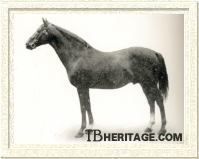
Vitez
| |
SEATON DELAVAL (1889, from Rosedale, by Rotherhill), won six of his twenty-four races, including the 1893 Northumberland Plate over two miles and York's Great Northern Handicap. SEATON DELAVAL was sold to New Zealand where he went to stud at Wellington Park Stud on the North Island. There, Seaton Delaval enjoyed a highly successful stud career. He was leading sire in New Zealand twice, the seasons of 1903-1904 and 1906-1907. He got twenty-two stakes winners, exactly half of which won at the equivalent of the Group I level. Seaton Delaval was the broodmare sire of seventeen stakes winners, as well.
|
SEATON DELAVAL'S best runner was undoubtedly the great racemare Gladsome (1900), winner in both New Zealand and Australia of such races as the CJC Oaks, the Caulfield Stakes, the Melbourne Stakes, the Wellington Cup, the Auckland Plate, and thirteen other stakes. Other good winners by SEATON DELAVAL included: Beddington, winner of several stakes, including the New Zealand St. Leger; Idas, winner of the Great Northern Foals Stakes and Avondale Cup; Lady Lucy, winner of the New Zealand Cup and dam of Star Lady, a victress in the Great Northern Oaks. SEATON DELAVAL also got Miss Delaval, victress in the CJC Oaks Stakes and New Zealand St. Leger, and other high class winners, including Nonette, Sea Elf, Silkworm, and Van Rosa. When the Wellington Park Stud was dispersed in 1905, Seaton Delaval went to Whitford Park Stud, Manurewa, near Auckland, where he spent the remainder of his life.
Sold to Italy
In 1890, the Italian government sent a committee to England to purchase a good horse, and Melton, a Derby and St. Leger winner, could be had. In Italy he was very successful, but even though his son, ARCONTE, got three Italian Derby winners, Melton's sire line in Italy would have ended there, had it not been for the importation of his English-bred grandson, Signorino, which sent the line forward to the mid-twentieth century.
One of Melton's first Italian stars was the colt GOLDONI, out of the Beaudesert mare Venetia, foaled in 1893. Goldoni was the best three-year-old colt of his year in Italy, capturing the Derby Italiano, St. Leger Italiano, and Premio Pisa. He had no recorded progeny.
In 1894 came HIRA, out of Proserpina, by the Blair Athol stallion Andred. As a three-year-old in 1897 she was dominant, capturing the Derby Italiano, St. Leger Italiano, Gran Premio di Milano, and Premio Pisa. Sadly, she, too, had no progeny of record.
ARCONTE (1896 from the Andred mare Arcadia) was an Italian classic-placed son of Melton, finishing second in the Derby Italiano. At stud, Arconte came up with three exceptional performers: Belbuc, winner of the Derby Italiano and Premio Pisa; Dedalo, winner of the Derby Italiano, St. Leger Italiano, and Premio Parioli (Italian Two thousand Guineas); and Nettuno, winner of the Premio Parioli and Derby Italiano and second in the Premio Pisa. But none of these sons were able to continue the sire line; ARCONTE is best known now as an excellent broodmare sire. From the same foal crop as ARCONTE came Gran Premio de Milano winner MARCANTONIO, who like HIRA and ARCONTE, was out of a daughter by Andred.
|
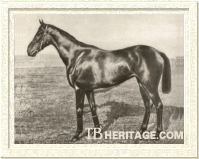
Lucie, born in France
| |
In 1897, came Melton's daughter LUCIE. Born in France, LUCIE was out of the mare Livie, a product of English Derby winner Silvio's stud career in France. LUCIE was a fine two-year-old, capturing both the Prix Morny and the Prix de la Rochette, and in England was third to Democrat and Vain Duchess in the Coventry Stakes at Ascot, carrying a weight penalty for her wins in France. As a broodmare, she produced El Tango, a winner of the Prix Dollar; Mehari, a winner of the Prix Morny at two and the Prix Hocquart at three. Mehari was exported to Argentina for stallion duty, and there is remembered as the sire of the great mare Mamita, dam of two winners of the Gran Premio Nacionale in Bermejo and Lacio. Bermejo also had a win in the Gran Premio Jockey Club. |
Brought Back to England
Melton's success in Italy did not go unnoticed. In 1896 he was purchased by John Musker who was establishing his first stud and dove right in by paying £12,000 for Melton and shipping him back to England. Treated like a king by the staff of Musker's Westerham Hill Stud in Kent, for which Musker laid out thousands more for several thousand acres and the most up-to-date equipment, the stallion was given almost palatial living accommodations, his stall in the stud barn being equipped with a marble feed manger.
This time around in England, Melton proved more successful. In 1900 he was fifth in the stallion lists, with ten winners of £13,437; in 1903 he was sixth, with eleven winners of £12,078.
The first useful offspring sired by Melton after his return to England was the chestnut colt BRZASK. He was out of the Isonomy mare St. Osythe. Foaled in 1898, BRZASK'S racing career took place in Poland, where his wins included the Nagroda Produce Stakes and the Nagroda Iwna and a second place in the Nagroda Derby. At stud in Poland, BRZASK sired Grojec, a winner of the Nagroda Iwna; Jerzyna, winner of the Nagroda Produce Stakes; and Giercza, winner over colts in the Nagroda St. Leger. BRZASK was also the broodmare sire of Widzowianka, winner in 1921 of the Nagroda Iwna.
|
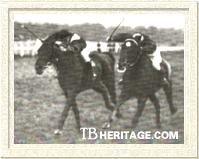
Princess Melton (Left)
| |
PRINCESS MELTON was also a member of Melton's 1898 foal crop. Out of School-book, by Wisdom, she was a brilliant juvenile, accounting for the Sefton Park Plate, the Acorn Stakes, the Summer Breeders' Foal Plate, Molecomb Stakes, the Michaelmas Stakes and the Bretby Stakes as a two-year-old. She was not exemplary as a producer for J.B. Joel, but one of her daughters, the Persimmon filly Volterra, became the dam of Volumnius, winner in 1931 and 1933 of the Grosser Preis von Dusseldorf. |
LORD MELTON (1898) was a son of the Rosebery mare La Rosiere. His victories included the Priory Stakes and the Sudbury Stakes. MELTONIAN, foaled in 1900 from Argenta, by the Galopin stallion Pioneer, was exported to the United States, where he won the Champagne Stakes as a two-year-old. Another foal in this crop, BAY MELTON (1898, from Limosa by Ouragan) won Ascot's New Stakes (Norfolk Stakes) as a juvenile. BRITANNIA (1898), out of Britta, by Melton's old rival Paradox, won Lincoln's Brocklesby Stakes at age two. In the breeding shed BRITTANIA was the dam of the William the Third colt Battle-Axe, victor over King Edward VII's Minoru in the 1908 July Stakes. Another good juvenile in the 1898 crop was TODDINGTON, out of Minera, by Galopin, who took Epsom's Woodcote Stakes.
HENRY THE FIRST (1901 from the St. Simon mare Simena) won seven races worth £12,009, and was eight times second or third. He took the Dewhurst Stakes and three other races in six starts at two, and at age three won the Newmarket Stakes and was second to Pretty Polly in the St. Leger, second to Rock Sand in the Jockey Club Stakes, and third to St. Amant in the Two Thousand Guineas. When Musker dispersed his stud, the first time, in 1906, HENRY THE FIRST, his brother, WILLIAM RUFUS, and Melton were the only horses he retained. HENRY THE FIRST and WILLIAM RUFUS were leased to Continental interests for several years before Musker reconstituted his stud at Thetford in Norfolk, but both Melton sons were comparative failures as stallions. HENRY THE FIRST'S best runner was probably First Flier (1914, from Grey Flier by Friary), a winner of the Irish Derby and champion of his year in Ireland in 1917; his daughter, Coraline (1910) won four good races in France, and daughter Piccola took six races in Italy.
|
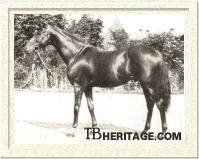
William Rufus
| |
A member of Melton's crop of 1900, WILLIAM RUFUS was a full brother to HENRY THE FIRST. He had the misfortune to have been born in the same foal crop as Rock Sand, winner of the English Triple Crown in 1903. WILLIAM RUFUS tried, but could never get the better of that rival, and is to be taken into account when assessing his record of six wins and ten times second or third. He was second to Rock Sand in the Champagne Stakes at two, second to him in the St. Leger and third to Rock Sand and brother HENRY THE FIRST in the Jockey Club Stakes at three. He was also second to Bachelor's Button in the Champion Stakes as a four-year-old. WILLIAM RUFUS did win the British Dominion Two-Year-Old Plate (beating Chaucer and Hammerkop), Duchess of York Stakes, Royal Stakes, Midsummer Stakes, Gratwicke Stakes, and the Great Northern St. Leger. |
WILLIAM RUFUS was retained at Melton Stud, where he spent two years; when Musker dispersed his stud the first time, WILLIAM RUFUS was sent to Hungary from 1907 through 1909, and then was repatriated to England in 1910. He got King's Common (1911), a winner of three races as a juvenile, including the Railway Stakes at the Curragh, and never unplaced, and Scarlet Rambler (1913), a winner of the Royal Whip at the Curragh in 1916. WILLIAM RUFUS' British-bred daughter Tuscan Red, was exported to the United States, where her initial produce record was disappointing, despite being bred to the likes of Man o' War, Celt, and High Time. Her family bred on, and over the decades has included such stars of the American turf as Chateaugay, Primonetta, Little Current, Barbaro, and Hard Spun.
HIS MAJESTY (1901) was out of Silver Sea, a full sister to Shotover. He twice won the Biennial at Newmarket, was third to Pretty Polly in the 1904 Free Handicap and again third to her in the March Stakes two years later. In 1905 he won the two-mile Goodwood Stakes. HIS MAJESTY was a moderate stallion, nowhere near the class of his sire.
AVELINE, a chestnut filly foaled in 1906, was out of a daughter of Isinglass. Sent to Austria, she captured the Oesterreichisches Stutenpreis as a three-year-old, and later became the dam of Ascanio, twice winner of the Jubilaums Preis, in 1923 and 1924, and also in 1924 a winner of the Milleniumi dij. Aveline's daughter, Avenel, was another good runner for her dam, placing second in the 1919 Nagroda Derby in Poland.
The St. Serf mare Back Chat was covered by Melton prior to being exported to Australia. There, in 1907, she produced the colt REPARTEE. He was not an outstanding racehorse, but his pedigree garnered him a place at the Dyraaba Stud of John H. S. Barnes, located in the Richmond River district of New South Wales, where he got Norbury (1912), who won the Newcastle Cup during his turf career, and Rivoli (1919), who annexed the AJC Derby, AJC Craven Plate, AJC Randwick Plate, the C. B. Fisher Plate, VRC Governor's Plate, and Melbourne Stakes. He also placed second in the 1923 Melbourne Cup to Bitalli, carrying 29 pounds more than the winner.
Rivoli moved with Barnes' bloodstock to Canning Downs Stud in Queensland, where he got multiple winners of the Queensland Guineas and Queensland Cup. As a broodmare sire he was represented by Tea Rose, winer of the AJC Derby, Craven Plate, STC Canterbury Stakes, and STC Rosehill Guineas; Doncaster Handicap winner The Diver; and Basha Felika, winner of the QTC Derby, St. Leger Stakes, , Moreton Handicap, and VATC Caulfield Cup.
As a broodmare sire, REPARTEE was responsible for Queensland Derby winner Hendra Lad and BATC Doomben Cup winner Repshot.
|
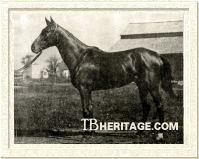
Sysonby
| |
Of all Melton's progeny, his masterpiece was undoubtedly SYSONBY. The story of SYSONBY, considered one of the greatest of American racehorses, began in England through the efforts of Irish-born American businessman Marcus Daly. In 1881, Daly purchased the Anaconda Silver Mine in Butte, Montana from Michael Hickey. Copper was soon discovered at Anaconda, and Daly, in partnership with George Hearst and James Ben Ali Haggin, developed Anaconda into one of the most profitable copper mines in the world. By 1895, Daly had become a millionaire. |
Daly used his wealth to dabble in several interests, one of them being the breeding of racehorses. He had Bitter Root Stud near Hamilton, Montana and Apperfield Stud in England established to achieve his breeding goals. One of his broodmare purchases was Optime, a daughter of dual Eclipse Stakes winner Orme. She was kept at Apperfield and bred to Melton. Daly died in 1901, and his horses were shipped to the United States to be sold in a dispersal at Sheepshead Bay, New York, on October 1, 1901. Optime, in foal to Melton, was knocked down to James R. Keene, master of Lexington's famed Castleton Stud, for $6600. On February 7, 1902, Optime foaled a colt by Melton. As a play on his sire's name, Keene's son, Foxhall, named the colt SYSONBY, after a hunting lodge he leased near Melton Mowbray in England.
Little was thought of SYSONBY as a young horse, and the elder Keene decided to sell him, but was dissuaded from doing so by his son. Despite the fact that he was described as a "common, cheap-looking, lop-eared colt," there was some visible quality about the colt. Trainer James Rowe saw it, and wishing to keep the colt from being sent to Keene's stable in England, went to great lengths to make it appear the colt was too ill to travel, swathing him in bandages when his employer came to inspect the horses scheduled to be shipped to England.
SYSONBY rewarded the faith of both Foxhall Keene and his trainer. He won his first race by ten lengths, then in succession took the Brighton Junior Stakes, Flash Stakes, and Saratoga Special. He won these first four races by a combined margin of 34 lengths.
SYSONBY ran an uncharacteristically dull third to the fillies Artful and Tradition in the Futurity, and it later transpired his groom had been paid generously into drugging the colt with bromidian to fix the race. He came back a few weeks later to capture the Junior Champion Stakes, and with it, laurels as the champion two-year-old colt of the year.
SYSONBY captured each of his nine starts at three, including a dead-heat victory with Race King in the Metropolitan Handicap, the Lawrence Realization, Iroquois Stakes, and Great Republic Stakes.
Early in his four-year-old season, Sysonby became ill with bleeding sores. From the time one bleeding sore appeared to only a week later, on June 17, 1906, the brilliant colt died, killed by what was believed to be liver disease compounded by variola, a virus which causes smallpox in humans. After having his body initially buried in front of the Keene stables at Sheepshead Bay, his body was exhumed and the skeleton put on display at the American Museum of Natural History in New York City, where it still is today.
Melton's Broodmare Daughters
As a sire of broodmares, Melton enjoyed considerable success. He never led the English broodmare sire list, but was second to Gallinule in 1913 -- with eighteen daughters producing winners -- which included Absurd, Black Jester, Drinmore, and Hidalgo -- and in the top ten on nine other occasions. The vast majority of Melton's stakes-producing daughters had been of little account on the racecourse; indeed the greater percentage of his top performers were colts. In the breeding shed, however, it was a different story, as Melton did not get a siring son to compare with himself, but the daughters brought something to the table when crossed with the leading sires of the day.
Most significant were his classic-producing daughters, and what a remarkable trio they were. Each one represented one of the three eras of Melton's stud career. The eldest, MISS MILDRED, born in 1890, was a member of the early crops Melton sired in England. YOURS represented Melton's years in Italy, for she was foaled in that country in 1894. Finally, ABSURDITY was one of the representatives of Melton's repatriation to England. Of the three, ABSURDITY won two small races.
MISS MILDRED was out of Young Melbourne's daughter Merino. Her owner, the 6th Duke of Portland, bred her to his mighty St. Simon to get the bay filly La Roche, foaled in 1897. La Roche was the best three-year-old filly of her generation, capturing the Oaks, Yorkshire Oaks, Newmarket Oaks, and the Manchester Cup. As a broodmare at Portland's Welbeck Abbey Stud, La Roche produced Cannobie (by Polymelus), winner of the Jockey Club Stakes, and Almissa (by Ayrshire), exported to Australia, where he won several races, including the Moonee Valley Cup and Australian Cup. MISS MILDRED'S tail-female descendants included Thais, dam of Zukunfts-Rennen winner Guerryante, a filly by Flying Fox, who later produced the multiple stakes-winning French filly Guerriere.
YOURS was out of the Galliard mare Your Grace, and was bred in Italy by Razza Sansalva. She was acquired by English breeder Jack Joel, and for him bred two classic winners. The first was the Ayrshire filly Our Lassie, foaled in 1900. She was a victress in the Oaks Stakes. Through her daughter, the Sundridge filly Lady Brilliant, Our Lassie was ancestress of such important individuals as Imprudence, victress in both the English and French One Thousand Guineas and English Oaks, as well as Black Ray, Eclair, Khaled, Infra Red, Jacopo, Foray, and Mill Reef.
Five years later, to a mating with Persimmon, YOURS foaled the colt Your Majesty, winner for Joel of the St. Leger and Eclipse Stakes and sire of One Thousand Guineas and Oaks winner Princess Dorrie. Exported to Argentina, Your Majesty proved highly successful, leading the Argentinean sire list twice.
YOURS had a younger full sister, OUR GRACE, who became the dam of Prix du Jockey Club champion Or du Rhin, by St. Damien.
|
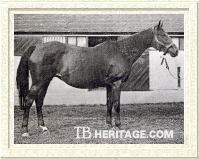
Absurdity
| |
The youngest in the trio of Melton's classic-producing daughters was ABSURDITY, foaled in 1903. Her dam was Paradoxical, by Timothy, out of a full sister to Melton's old racetrack rival Paradox. Like YOURS, ABSURDITY produced two classic winners for Jack Joel. The first of these was the moody Jest, a chestnut daughter of Sundridge. She captured the One Thousand Guineas and Oaks in 1913. Her stud career seemed a failure until she gave birth to the blazed-face chesnut, Humorist, by Polymelus in 1918. Humorist won the Derby Stakes, only to die suddenly from a massive hemorrhage of the lungs a few weeks later. It was discovered Humorist had been afflicted during his short life by tuberculosis. His loss was all the more keenly felt when his dam died from an infection the same spring. |
A year younger than Jest was Black Jester, a brown colt by Polymelus. Like his half-sister Jest, Black Jester was renowned for a moody and unpredictable temperament. He was a top class performer, even if he did lose some races because he refused to exert himself. During his career, in addition to the St. Leger, he took the Richmond Stakes, Sussex Stakes, Molecomb Stakes, St. George Stakes, and City and Suburban Handicap. He was second in the Champion and Princess of Wales's Stakes and third in the Two Thousand Guineas. Black Jester was not a significant success at stud, though he did sire the in-bred Black Ray (out of Our Lassie's daughter Lady Brilliant), Black Domino, dam of Grand Prix de Paris winner Barneveldt, and Midnight Folly, dam of French Two Thousand Guineas winner Drap d'Or.
ABSURDITY also was the dam of Absurd, a full brother to Jest who became a five-time leading sire in New Zealand. A three-quarter sister to Jest and Absurd, the Sunstar filly Gesture, became the matriarch of a family through her daughter Amuse, which has included classic winners Picture Play and Fairy Footsteps.
ABSURDITY'S full sister, DOXA (1901) was purchased by Jack Joel's brother, Solomon Barnato "Solly" Joel for 200 guineas. She was worthless on the racetrack, being unplaced twice at four. She is remembered as the second dam of the French classic-winning filly Adargatis, and of the latter's three-quarter sister -- La Troienne, arguably one of the most influential broodmares of the twentieth century.
ATTRACTIVE, a filly out of Macaroni's daughter Mirobolante, was born in 1888. Her best racetrack performer was the French-bred and raced colt Arizona, winner of the Prix Daru.
GREEBA was a filly by Melton foaled in 1890 from the Springfield mare Sunrise. She became the dam of the good racehorse Eager, an Enthusiast colt foaled in 1894. Eager's victories included the July Cup, the Derby Gold Cup, the Portland Plate, Wokingham Stakes, and two editions of the Rous Memorial Stakes. Eager was a good sire, his daughter Electra capturing the One Thousand Guineas in 1909, and his son Jaeger running second to Sweeper in the Two Thousand Guineas of 1912, and second to the filly Tagalie in the Derby.
From the Julius mare Consolation, Melton was the sire of KISS, a member of the 1891 foal crop, and Melton's last before he was sent to Italy. Her daughter by the Bend Or stallion Orvieto, named Keepsake, was a winner in Italy of the Gran Premio di Milano.
Also foaled in 1891 was ROSE BAY. She was exquisitely bred, for her dam, Rose of Lancaster, was a full sister to the 1st Duke of Westminster's Derby champion Bend Or. Bred to the Duke of Portland's classic winner Ayrshire, the resultant foal, a colt, was Robert le Diable. Despite his wonderful pedigree, Robert le Diable was not an outstanding performer on the turf. He won some important races, but he was never up to classic standard. He got better as he got older, and upon his retirement from the track, had victories in the City and Suburban Handicap, Duke of York Stakes, and Doncaster Cup to his credit.
At stud, Robert le Diable sired useful winners, his best being Wrack. This individual was exported to the United States to stand at Arthur Hancock's Claiborne Farm near Lexington, Kentucky, and proved very successful, some of his best offspring being the stakes winners Blazes, Petee-Wrack, the champion filly Careful, and Flambino, the latter the dam of American Triple Crown champion Omaha.
Italian Daughters as Broodmares
Melton's daughter PUNDA, foaled in 1895, was a year-younger full sister to the top-notch Italian filly HIRA, being out of Proserpina, by Andred. She became the dam of Sambar, a Galeazzo colt foaled in 1907. Sambar captured the Premio Pisa and was third in the Derby Italiano. He had no progeny of record.
ALTA, out of Alice, by Wellingtonia, was foaled in 1896. She became a member of the broodmare band of French breeder Edmund Blanc. She produced full siblings by Flying Fox, the filly Sidia, victress in the Prix La Rochette, and her younger brother, Jarnac, winner of the Prix Isonomy.
Back in England
Upon his return to England, one of the mares brought to be bred to Melton at Westerham Hill Stud was Adderly, a daughter of Ayrshire and the high-class Doncaster filly Sandiway. The result of this union was the bay filly AUNTIE MUM. She was sold to American breeder Henry T. Oxnard. For Oxnard, she produced Spur (by King James). Spur, sold to James Butler, was a consistent, hard-knocking racetrack performer, winning at least twelve stakes, including the Travers Stakes and Withers Stakes. He proved a very useful sire, his best being Butler's good colt Sting, winner of the Suburban and Metropolitan Handicaps in 1925. The male line bred on, with Sting's son, Questionnaire, capturing the Metropolitan and Brooklyn Handicaps and siring Free For All, a brilliant two-year-old stakes winner who became the sire of Rough 'n Tumble, winner of the Santa Anita Handicap and sire of Dr. Fager, American Horse of the Year in 1968 and inductee to the National Museum of Racing and Hall of Fame.
|
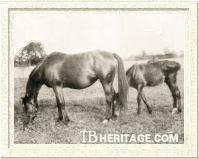
Bronze Medal
| |
In the new century, Melton kept up his record as a sire of quality producing broodmares. BRONZE MEDAL, foaled in 1901 from Britta, by Paradox, and so sister to BRITANNIA, was purchased at the first Melton Stud dispersal by Madame Lemaire de Villers. At the Haras Becquet Saint-Paul in Beauvais, France, she produced the Rabelais filly La Ribaude, winner of the Criterium de Saint-Cloud. DUNSE and GLUCOSE, both came along in 1903. The former, out of Dunover, by Donovan, became a broodmare in Argentina, and there, to the cover of the Gay Hermit stallion Batifondo, produced Tic Tac, winner in 1919 of the Grande Premio Bento Goncalves in Brazil. The latter, Glucose, was out of Glue, by Isinglass. Her son, Stick To It, was classic-placed in France. |
LOVELORN, a chestnut filly by Melton was foaled in 1907. Her dam was the Orion mare Hebrew Maid. Bred to Melton, Hebrew Maid was exported immediately thereafter to New Zealand, and it was there she dropped her Melton filly. LOVELORN became an extraordinarily successful producer. To the cover of the Martagon stallion Martian, she produced three important stakes winners; the colt Menelaus, whose wins included a score in the New Zealand Cup; the filly Nones, victress in the McLean Stakes and Wanganui Guineas; and the filly Lovematch, whose victories included the Hawkes Bay Cup and Wanganui Cup. LOVELORN was also the dam of Prince Paladin, a gelded son of Paladin, who won several stakes in his native New Zealand and then crossed the Tasman to Adelaide, South Australia, where he carried 137 pounds to a record-tying Australasian time of 1:19 for six and a half furlongs.
One of the greatest fillies to race in Argentina was the Val d'Or filly Ocurrencia, foaled in 1919. She was out of Melton's daughter MELTONA, who was out of a mare by Orion. Ocurrencia was all-dominant as a three-year-old in 1915, capturing the Clasico Olavarria, Gran Premio Ignacio Correas, Gran Premio Selecion, Gran Premio Polla de Potrancas, Gran Premio Carlos Pellegrini, and Gran Premio Jockey Club. As a four-year-old, she took her act to Chile, there taking the Clasico Chile and Clasico Suipacha. At stud, Ocurrencia produced nothing of the quality of herself. Her full brother, Sin Rumbo, was a decent sire in Brazil.
Melton's daughter, LA ZINGARA, was exported from England to Haras Las Ortigas, near Buenes Aires, Argentina, in 1907. She was covered by the stud's premier stallion, recently-imported English Triple Crown champion Diamond Jubilee, for the 1908 breeding season. The result was the colt Last Reason (1909). On the racecourse, Last Reason won twenty-nine races, including the Clasico Coronel Pringles, Clasico Porteno, Clasico Clausura, Clasico America, Clasico Santiago Lawrie, and Clasico General Alvear. As a stallion in Chile, Last Reason led the Chilean sire list three timesí in 1926, 1927, and 1928. He stood first at Haras San Miguel, through 1924, and then was sent to Haras Tiburones, standing there until his death at age seventeen in 1926. He sired 75 winners that earned the equivalent of over two million dollars, including Madrigal, a winner of seven races; Murga, winner of sixteen races; Barbaridad, winner of La Prueba, Premio Primavera, and Premio Guillermo Errazuriz Urmeneta; and Ardelion, winner of several important races, including the Premio Velocidad, Clasico Comparacion, La Huasca, and the Premio Santiago Garcia Mieres.
Some other noteworthy producers by Melton were FIRST FLIGHT (1889 out of Selection, by Hampton), dam of the Polish-bred Sac-a-Papier, winner of the Gosudaryni Imperatricy in Moscow in 1899 and second in the Nagroda Derby in Poland; SWISS GIRL (1899, out of Monte Rosa, by Craig Millar), dam of Saucy Girl, victress in the 1911 Nemzeti dij; SIMENA'S DAUGHTER (1906 out of Simena, by St. Simon), dam of British-bred and American-raced champion filly Constancy, a 1917 daughter of Ambassador IV; MEMORIA (1909 out of Shotsilk, by Matchmaker), dam of Fleeting Memory, a Vencedor colt whose victories included the Stewards Cup and the Victoria Cup; and MELTON'S GUIDE (1910 out of Knowledge, by Wisdom) the dam of Jack Horner, a chestnut gelding by Cyllius and winner of the 1926 edition of the Grand National at Aintree. American champion colt In Memoriam and One Thousand Guineas victress Roseway each had Melton mares as their second dams.
Throughout his racing and stud careers, Melton was resilient and reliable. He was not bred at the height of fashion and was not the most imposing physical specimen, but he was a top class performer on the English turf. He never made it to the top of the sire lists, but he was always knocking. He was a classic sire in Italy and a good, reliable sire of high-class performers in England. He gave the American racing world a nearly-undefeated champion, and daughters that were highly sought after as broodmares.
Melton lived to the great age of 28, dying on November 26, 1910. Two of his hooves were made into inkwells. They, along with his mounted head, were put on display at Rushford Hall in Norfolk, England.
--Elizabeth Martiniak
|
|
|
|

